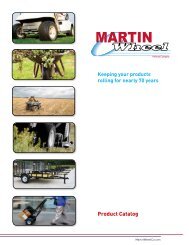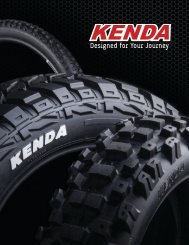Create successful ePaper yourself
Turn your PDF publications into a flip-book with our unique Google optimized e-Paper software.
Basic Tire Facts<br />
In an effort to clarify the confusion in tire sizing we offer the following:<br />
Lawn and Garden, Industrial, ATV and Go-Kart Tires<br />
There are two methods of identifying tires in this category:<br />
Overall Diameter x Section Width x Rim Diameter.<br />
An example of an L&G tire size is 13/6.50-6.<br />
An ATV tire size is 22/1100-8.<br />
BASIC TIRE FACTS & DEFINITIONS<br />
Facts & Definitions<br />
Section width x section height x rim diameter<br />
An example of this type of tire is 5.30/4.50-6.<br />
Bicycle, Lawn Cart and High <strong>Wheel</strong> Mower Tires<br />
Overall diameter x section width<br />
An example of this tire size would be12x1.75<br />
Basic Tire Definitions<br />
Ply Rating<br />
Bead width<br />
Section Width<br />
Section Height<br />
Overall Diameter<br />
An index of the tires strength; ply rating indicates<br />
the maximum recommended load for specific<br />
types of service. Ply rating normally does not<br />
indicate the number of plies or layers in the tire.<br />
The distance between the vertical portions of the<br />
rim flange. If the rim is too wide or narrow, the<br />
tire will not seat properly. As a rule, bead widths<br />
should be ½” to 1 ½” narrower than the section<br />
width of the tire to provide for a proper fit.<br />
The distance across the tire at its widest part<br />
when inflated but not under load.<br />
The distance between the top of the tire and the<br />
bead seat when the tire is inflated but not under<br />
load.<br />
The distance from the top to the bottom of the tire<br />
when it is inflated but not under load<br />
19













